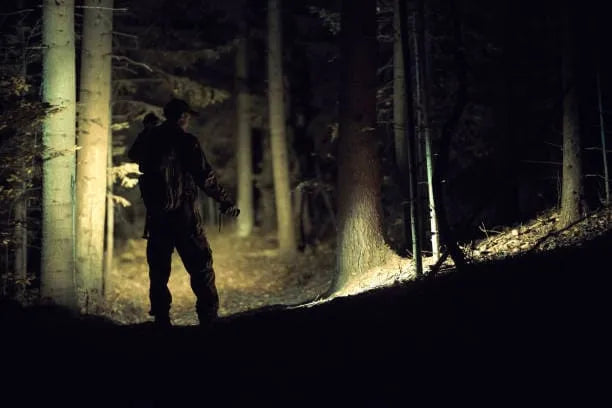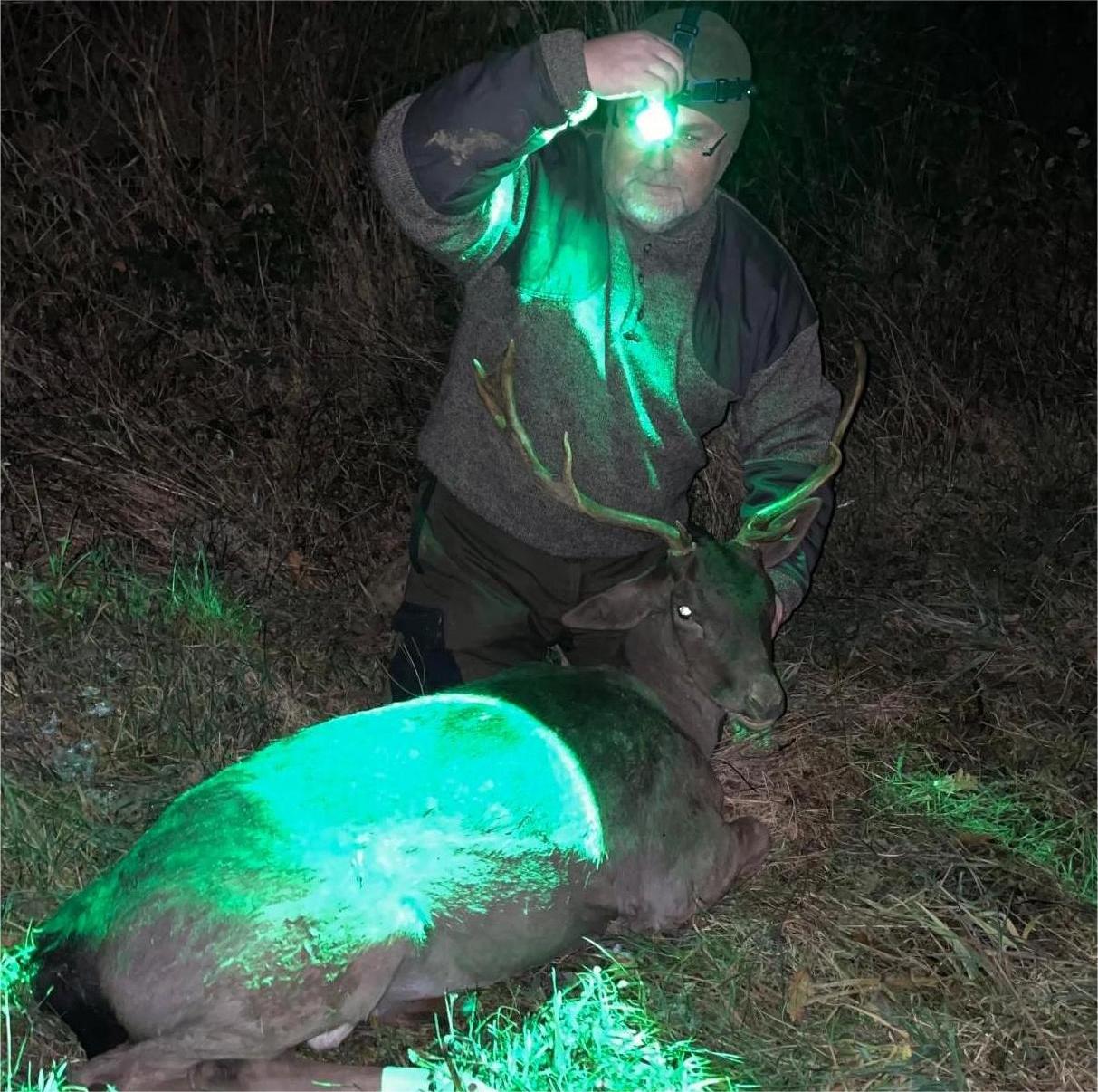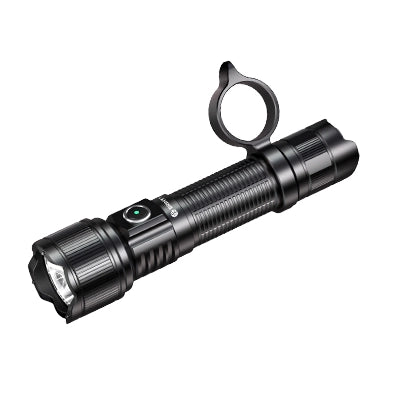To stay safe and undetected in the Nordic wilderness, hunters should use low-output red or flood light for movement, reserve Turbo for short scanning, protect batteries from cold, and choose IP-rated flashlights that allow quick mode switching even with gloves. Correct light discipline improves stealth, extends runtime, and prevents gear failure in freezing conditions.
Introduction – Why Lighting Mistakes Cost More Than a Missed Shot
Most hunters prepare their rifles, camouflage, and calls with precision—but overlook one critical element: light discipline. In low-light Nordic forests or the cold woodlands of North America, a single lighting mistake can spook game, drain your battery, expose your position, or leave you helpless when it matters most.
Understanding how to use your headlamp and flashlight with tactical awareness is just as important as bullet drop compensation or wind reading. The following are the most common lighting mistakes hunters make—and how to avoid them with field-proven techniques and gear strategy.
Mistake #1 – Choosing the Wrong Beam Pattern at the Wrong Time
Many hunters leave their lights in one mode the entire time. Flood and throw light serve completely different purposes, and using the wrong one can ruin a perfect setup.
| Situation | Best Beam Type | Why It Matters |
| Walking through dense forest | Floodlight (wide beam) | Illuminates surroundings without tunnel vision |
| Scanning a far treeline or valley | Throw light (narrow beam) | Focused beam to detect eye shine without lighting up the entire area |
| Sitting in ambush | Minimal flood, low output | Keeps you aware without alerting wildlife |
Example Gear Application
A headlamp like Brinyte HL28 Artemis offers wide flood + adjustable throw, making it perfect for transitioning between scanning and movement without switching devices.
For long-range scanning, a Brinyte T28 or T40 throw light provides a tight beam to spot eyes hundreds of meters ahead without broadcasting your position.

Mistake #2 – Running Turbo Mode Too Early and Too Often
The moment hunters step into the woods, many immediately switch to Turbo mode, thinking brighter is always better.
Reality: Turbo is a tactical burst mode, ideal for short scanning or confirming a shot zone—not for constant walking.
Why Turbo Overuse Is a Critical Mistake:
- Drains battery fast, especially in cold Nordic or Canadian conditions
- Generates heat, causing sudden lumen drop (thermal step-down)
- In freezing weather, batteries lose voltage faster, meaning high-drain modes fail sooner
Field Advice
Keep your light at mid or low mode during movement. Use Turbo briefly to scan ahead, then return to low output.
Lights like Brinyte PT28 Oathkeeper have a quick-access tail switch for tactical bursts, allowing controlled Turbo use without menu diving.
Mistake #3 – Ignoring Light Color Strategy (White vs Red vs Green)
White light offers full clarity—but also destroys night vision and alerts game immediately.
| Light Color | Best Use Case | Wildlife Reaction |
| Red Light | Map reading, quiet movement, checking gear | Least disturbing to deer, boar, and fox |
| Green Light | Long-range scanning without spooking | Enhances contrast on animal eyes |
| White Light | Shot confirmation, navigation in danger zones | Should be used sparingly when approaching final shooting distance |
Tactical Application
Headlamps like Brinyte HL28 or HC01 with red/green light modes let hunters maintain stealth while preserving night vision—crucial when waiting in a hide or approaching a bait site.

Mistake #4 – Poor Battery Planning & Backup Strategy (Especially in Cold Weather)
Many hunters bring one fully charged flashlight and think it's enough. In Nordic and North American winter hunts, that’s a serious risk.
Common Battery Failures:
- Cold temperature voltage drop → battery appears dead even when 40% charge remains
- Only carrying one battery → no backup for extended tracking or recovery
- No USB backup → inability to recharge in field
Recommended Strategy
- Carry two 18650 or 21700 cells, stored close to body heat (pocket or inner pouch)
- Use lights with USB-C direct charging, like Brinyte PT28 / T28, to recharge using a power bank
- Withdraw batteries from freezing gear, rotate them to keep warm, especially during long ambush in snow

Mistake #5 – Entering the Field Without Testing Light Interface & Modes
You should never discover your light’s interface during a hunt.
Checklist before leaving camp:
- Can you switch modes blindly with gloves on?
- Does your headlamp remember last mode or default to bright white?
- Does the tail switch activate Turbo instantly, or require multiple taps?
- Are O-rings sealed to handle moisture and snow?
Many hunters prefer lights like Brinyte PT28 because the tactical tail switch activates a strobe or high beam instantly, even with cold fingers or gloves.
Mistake #6 – Improper Handling in Wet, Snowy, or Icy Conditions
In Nordic forests and Canadian mountains, condensation and cold shock are real threats to lighting gear.
Gear Protection Tips:
- Choose IP66 or IP68 waterproof-rated lights
- Wipe lenses frequently — frost can scatter light and reduce visibility
- Apply silicone grease to O-rings to maintain waterproofing in cold expansion
- Store backup batteries in thermal wraps or near your core layer
Lights like Brinyte T40 and HL28 are rated for harsh weather, making them reliable even after wet snow exposure or accidental drops into slush.
Pro Hunter Tips – How Experienced Trackers Use Light Discipline
Advanced Light Use Tactics:
- Walk in low mode, flashlight angled downward to avoid direct beam on horizon
- Scan terrain with throw beam from a distance, then move without light to close gap
- Switch to colored LEDs before entering shooting range
- Keep a compact backup light (like PT28) clipped to vest or belt, ready for instant activation
This controlled light strategy not only preserves power—but also keeps you invisible and unpredictable, exactly how a successful hunter should be.

FAQ – Lighting Questions Hunters Ask Before the Season
Q1: What light color scares animals the least during hunting?
Red light is the least disruptive, making it ideal for movement and gear check. Green light is preferred for scanning because it improves contrast without alarming most game.
Q2: Should I use Turbo mode while tracking an animal?
No. Turbo should be used for quick scans or shot confirmation. Continuous Turbo use drains batteries and reveals your position.
Q3: How do I prevent battery failure in freezing conditions?
Store spare batteries close to body heat and avoid leaving lights outside exposed to cold before activation.
Q4: Is a headlamp enough for hunting, or do I need a handheld flashlight?
Experienced hunters carry both: a headlamp for hands-free movement (like HL28) and a powerful throw flashlight (like T28 or T40) for long-distance spotting.
Q5: Why do some hunters prefer green light over red?
Green light travels farther and makes eye shine more visible, making it effective during distant scanning when positioned on higher ground or treelines.
Q6: What’s the best way to extend flashlight runtime during a multi-day hunt?
Use low or mid modes during movement, carry dual batteries, and ensure your light supports USB-C charging in the field.
Conclusion – Light Discipline = Silent Advantage
In wilderness hunting, light is not just visibility—it’s tactical communication. Used carelessly, it announces your presence. Used wisely, it becomes a precision scouting tool that guides, conceals, and supports your success.
Mastering beam control, color discipline, and battery management through real hunting conditions is what separates a prepared hunter from a lucky one.



